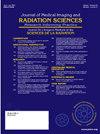Strengthening the Field: Estimating Ontario's MR Simulation Requirements Using RT-QBP Data
IF 1.3
Q3 RADIOLOGY, NUCLEAR MEDICINE & MEDICAL IMAGING
Journal of Medical Imaging and Radiation Sciences
Pub Date : 2025-05-01
DOI:10.1016/j.jmir.2025.101951
引用次数: 0
Abstract
Purpose/Aim
The use of magnetic resonance simulation (MR-SIM) in Radiation Therapy has increased over the last decade, however there is significant variation in access across the province. MR-SIM is an evolving strategy in radiation treatment planning, deemed essential for some disease sites while not adding value in others. Ontario Health (Cancer Care Ontario) initiated a project to determine when MR-SIM is most beneficial based on clinician feedback identifying disease site groups and specific Radiation Treatment Quality Based Protocols that will benefit from MR-SIM.
Methods/Process
Since the implementation of Radiation Treatment-Quality Based Procedures (RT-QBP) funding in 2019, the Radiation Treatment Program (RTP) at Ontario Health (Cancer Care Ontario) has been receiving protocol level information on every patient receiving radiation treatment in Ontario. RT-QBP data includes significant amounts of information including but not limited to disease site groups, sub-groups, intent (primary or metastatic), treatment modality (external beam, brachytherapy etc.), and even dose and fractionation. In March 2024, RT-QBP protocol lists were shared with various disease site experts to identify protocols that would require or benefit from MR-SIM.
Results or Benefits/Challenges
Upon review of RT-QBP protocols by disease site experts, the top 5 sites that benefit from MR-SIM include Head and Neck, Sarcoma, Central Nervous System, Gynecology and Genitourinary. The percentage of protocols that benefit ranged from 73% to 94%. Currently 4 of 16 radiation treatment facilities in the province have access to dedicated MR-SIM with the remaining sites gaining access through Diagnostic Imaging in various capacities, demonstrating the need for a strategic plan to ensure equitable access to aid improved accuracy in radiation treatment planning. This plan may include increasing MR-SIM access for centres with higher volumes or a shared resource approach for smaller centres that may not be able to fully utilize the capacity on MR-SIM. This work requires support from multiple programs and interprofessional partners.
Conclusions/Impact
This work may lead to new quality indicators for Radiation Therapy treatment, with MR-SIM being one of many possible quality indicators for treatment. A refined approach is necessary to determine the next steps. However, the impact of increasing access to MR-SIM for patients is far reaching and the implementation of RT-QBP reporting can be leveraged to streamline the approach.
加强领域:使用RT-QBP数据估计安大略省MR模拟需求
在过去十年中,磁共振模拟(MR-SIM)在放射治疗中的使用有所增加,但全省各地的使用情况差异很大。MR-SIM是放射治疗计划中的一种不断发展的策略,被认为对某些疾病部位至关重要,而对其他疾病没有增加价值。安大略省卫生部(安大略省癌症护理中心)启动了一个项目,根据临床医生的反馈,确定疾病部位组和特定的基于放射治疗质量的协议,确定MR-SIM何时最有益。方法/流程自2019年实施基于放射治疗质量的程序(RT-QBP)资助以来,安大略省卫生部(安大略省癌症护理中心)的放射治疗计划(RTP)一直在接收安大略省接受放射治疗的每位患者的协议级别信息。RT-QBP数据包含大量信息,包括但不限于疾病部位组、亚组、目的(原发性或转移性)、治疗方式(外置束、近距离治疗等),甚至剂量和分次。2024年3月,RT-QBP协议列表与各种疾病现场专家共享,以确定需要MR-SIM或受益于MR-SIM的协议。结果或益处/挑战根据疾病部位专家对RT-QBP方案的审查,MR-SIM获益最多的5个部位包括头颈部、肉瘤、中枢神经系统、妇科和泌尿生殖系统。受益的协议百分比从73%到94%不等。目前,该省16个放射治疗设施中有4个可以获得专用的MR-SIM,其余的地点可以通过不同能力的诊断成像获得,这表明需要制定一项战略计划,以确保公平获取,以帮助提高放射治疗计划的准确性。该计划可能包括为业务量较大的中心增加MR-SIM的访问,或为可能无法充分利用MR-SIM容量的较小中心采取共享资源的办法。这项工作需要多个项目和跨专业合作伙伴的支持。结论/影响这项工作可能导致新的放射治疗质量指标,MR-SIM是许多可能的治疗质量指标之一。需要一种精确的方法来确定接下来的步骤。然而,增加患者获得MR-SIM的机会的影响是深远的,RT-QBP报告的实施可以用来简化方法。
本文章由计算机程序翻译,如有差异,请以英文原文为准。
求助全文
约1分钟内获得全文
求助全文
来源期刊

Journal of Medical Imaging and Radiation Sciences
RADIOLOGY, NUCLEAR MEDICINE & MEDICAL IMAGING-
CiteScore
2.30
自引率
11.10%
发文量
231
审稿时长
53 days
期刊介绍:
Journal of Medical Imaging and Radiation Sciences is the official peer-reviewed journal of the Canadian Association of Medical Radiation Technologists. This journal is published four times a year and is circulated to approximately 11,000 medical radiation technologists, libraries and radiology departments throughout Canada, the United States and overseas. The Journal publishes articles on recent research, new technology and techniques, professional practices, technologists viewpoints as well as relevant book reviews.
 求助内容:
求助内容: 应助结果提醒方式:
应助结果提醒方式:


